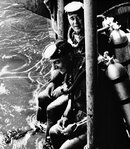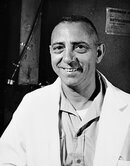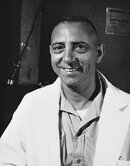Received this in my e Mail today.
One of our submarine heroes, as well as a diving pioneer.
Click on photos for larger size.
Bud Cunnally
To International Submariners
Today at 10:01 AM
http://www.nytimes.com/2014/08/27/u...0140827&nl=todaysheadlines&nlid=66203856&_r=0
Walter Mazzone Last of the USS Crevalle (SS291) Wardroom Dies at 96; Directed Navy Underwater Feats
By PAUL VITELLOAUG. 26, 2014
Inside
Photo

Capt. Walter F. Mazzone in the foreground with Capt. George F. Bond as they prepared to visit Sealab II off California in 1965. Credit U.S. Navy
Capt. Walter F. Mazzone played a pivotal role in two underwater Navy exploits during the 20th century. In World War II, he kept a waterlogged submarine from going belly up while it was carrying 40 Americans rescued from the Philippines. Twenty years later he helped organize the first Sealab tests of human endurance at crushing ocean depths — conducting the first tests on himself — which established the deepwater diving protocols still used by military and commercial divers today.
Captain Mazzone, who died on Aug. 7 at 96 in San Diego, was considered one of the Navy’s most exacting detail men in the underwater realm — where a millimeter’s leak, a workaday tangle and a molecule-size mistake are life-or-death matters.
On submarines, Captain Mazzone (pronounced mah-ZOH-nee) was the diving officer, in charge of taking the sub down, surfacing it and keeping it on an even keel when under attack. On Sealab experiments, he was the life-support man — helping divers descend hundreds of feet, stay below for weeks at a time and come back alive through a method he helped develop called “saturation diving.”
Photo

Captain Mazzone Credit U.S. Navy
The submarine rescue was kept secret during the war, and remained relatively little known afterward.
In May 1944, the Navy ordered his sub, the Crevalle, to surface just off the Japanese-held Philippine island of Negros, where it was to pick up two cargoes ferried out to it by Philippine resistance fighters. The first was a cache of Japanese battle plans they had captured; the second was the group of 40 Americans, many of them missionaries, including 28 women and children, who had been in hiding on the island since the beginning of the war.
Before reaching Australia 10 days later, the Crevalle’s commander, Francis D. Walker, spotted a Japanese convoy and, despite the danger it posed to his passengers, moved closer to attack. The Crevalle was spotted by the Japanese, who attacked first, damaging and partly flooding the sub.
With the sub listing, Captain Mazzone kept it under control for five hours as it maneuvered to escape while under almost continuous attack, according to an official account cited in a 2001 book, “The Rescue: A True Story of Courage and Survival in World War II,” by Steven Trent Smith.
Captain Mazzone, who was awarded the Silver Star and other medals, left the Navy after the war but rejoined it in the late 1950s to work with Capt. George F. Bond and others on research that would become the backbone of the Navy’s Sealab project.
In 1962, the team launched the 57-foot-long sausage-shaped underwater chamber known as Sealab I, which upended the conventional wisdom that, even with oxygen tanks, divers could not survive at a depth of more than 150 feet for more than a half-hour. The four divers in Sealab I remained at a depth of 192 feet for 11 days.
Captain Bond, a medical doctor, had pioneered the technique that made it possible: saturation diving, which virtually rewrote the chemistry of human respiration and temporarily transformed human divers into marine mammals.
The method involved replacing the sea-level mix of air (about 80 percent nitrogen and 20 percent oxygen) with a different mix (90 percent helium and 10 percent or less of oxygen) that could sustain human life underwater at great depths.
Captain Mazzone organized experiments showing that animals and humans (he was one of the first to try) could breathe the helium-oxygen mix and that divers (he was again one of the first testers) could acclimate to it in hyperbaric chambers. Sealab II, launched in 1965, kept crews at a depth of 205 feet for weeks at a time.
In 1969, the Sealab project was terminated after a Navy diver died while helping to fix a leak on the maiden mission of Sealab III, which was anchored at a depth of 600 feet off San Clemente Island in California. The cause was traced to an improperly filled air tank.
Ben Hellwarth, author of the 2012 history “Sealab: America’s Forgotten Quest to Live and Work on the Ocean Floor,” said that Mr. Mazzone was not in charge of preparations for Sealab III, and that things might have been different if he had been.
From the late 1950s to 1969, Captain Mazzone was a detail-obsessed overseer of the Sealab project. Crewmen called him Uncle Walter, Mr. Hellwarth said.
“Neither the Navy nor Dr. Bond would have gotten anywhere without Mazzone,” he said. “He was the anchor of the whole project.”
Walter Francis Mazzone was born in San Jose, Calif., on Jan. 18, 1918, the only child of Frank and Pearl Mazzone, immigrants from Italy. His mother was a department-store sales clerk, and his father worked in canneries. Mr. Mazzone had earned a degree in biological and physical sciences from San Jose State University and intended to go to medical school when World War II began in 1941. The Navy sent him to submariner school.
He reprised his role in the Crevalle rescue in August 1944, when, again as the diving officer, he safely maneuvered the submarine Puffer during a 30-hour attack by Japanese destroyers.
Captain Mazzone received a degree in pharmacology at the University of Southern California in 1948. While working on the Sealab project, he received a master’s degree from the Harvard School of Public Health. He retired from the Navy in 1970.
He is survived by a son, Robert, a retired Navy captain, who confirmed his death; two grandchildren; and five great-grandchildren. His wife, Lucie Margaret Oldham Mazzone, died in 2012.








